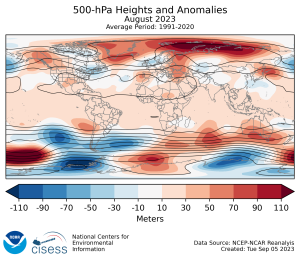
Although we’re only nine months into the year, five preeminent meteorological services have already declared that 2023 is on-track to become the hottest year on record—by a wide margin, at that. Although there is the outside chance that ’23 mightn’t reach this ignominious landmark, it would require global surface temperatures to drop significantly for the remainder of the year, a scenario that is extremely unlikely given not only the growing El Niño conditions in the Pacific tropics, but also the heat waves that are still generating sweltering conditions around the world.
The declaration that 2023 is going to be the hottest year on record was unanimously made by Berkeley Earth; Copernicus Climate Change Service; the Japanese Meteorological Agency (JMA); the National Aeronautics and Space Administration (NASA); and the National Oceanic and Atmospheric Administration (NOAA).
Although the year is far from through, each of the above agencies have expressed a high degree of confidence that this will be the case: NOAA is being the most conservative in their forecast, with a 93.42 percent chance that this year will top 2016/2020’s joint record; Berkley Earth is even more confident, reporting a 99 percent likelihood that 2023 will burst the bulb once again.
This past August was also the hottest month of August on record: NOAA recorded the month as being 1.25°C (2.25°F) above the 20th-century average of 15.6°C; NASA, using the 30-year average from 1951 to 1980, recorded the month as being 1.2°C (2.16°F) above normal; and Copernicus and the JMA clocked August as being 0.6°C (1.08°F) above the 1991-2020 time period.
But when placed within the context of the pre-industrial era, August 2023 was recorded as being a whopping 1.68°C (3.02°F) above the average temperature of the latter half of the nineteenth century, according to Berkley Earth. The past season—summer in the northern hemisphere—was also the hottest on record, according to NASA’s Jet Propulsion Laboratory.
“The months of June, July, and August combined were 0.41 degrees Fahrenheit (0.23 degrees Celsius) warmer than any other summer in NASA’s record, and 2.1 degrees F (1.2 C) warmer than the average summer between 1951 and 1980,” according to NASA’s press release. “August alone was 2.2 F (1.2 C) warmer than the average. June through August is considered meteorological summer in the Northern Hemisphere.”
“Summer 2023’s record-setting temperatures aren’t just a set of numbers—they result in dire real-world consequences,” remarked NASA Administrator Bill Nelson.
“From sweltering temperatures in Arizona and across the country, to wildfires across Canada, and extreme flooding in Europe and Asia, extreme weather is threatening lives and livelihoods around the world,” he continued “The impacts of climate change are a threat to our planet and future generations, threats that NASA and the Biden-Harris Administration are tackling head on.”
Although it is tied with 2020 as the hottest year on record, 2016’s record heat also occurred during a back-to-back, record-breaking El Niño event that saw that year’s average temperature hike to 1.25°C (2.25°F) above the pre-industrial average. It should also be noted that 2020 hit the same temperature despite the average temperature being brought down by the onset of the La Niña event that concluded earlier this year.
Subscribers, to watch the subscriber version of the video, first log in then click on Dreamland Subscriber-Only Video Podcast link.
2 Comments